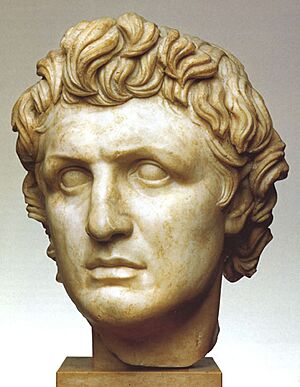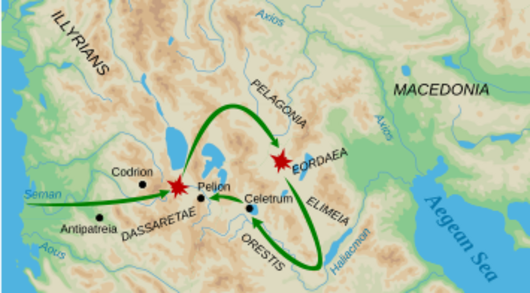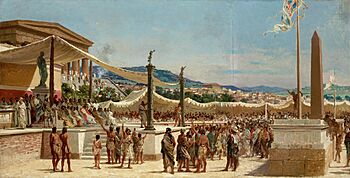Second Macedonian War facts for kids
Quick facts for kids Second Macedonian War |
|||||||||
|---|---|---|---|---|---|---|---|---|---|
| Part of the Macedonian Wars | |||||||||
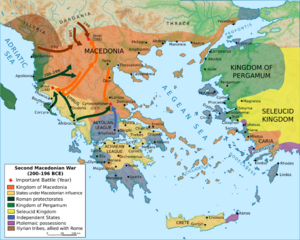 The campaigns and battles of the Second Macedonian War |
|||||||||
|
|||||||||
| Belligerents | |||||||||
|
Macedonia Boeotian League Acarnanian League |
||||||||
| Commanders and leaders | |||||||||
| Publius Sulpicius Galba Titus Quinctius Flamininus Attalus I Bato of Dardania Pleuratus III |
Philip V of Macedon | ||||||||
The Second Macedonian War (200–197 BC) was a big fight between the ancient kingdom of Macedonia, led by King Philip V of Macedon, and the powerful Roman Republic. Rome had strong allies like Pergamon and Rhodes. Philip lost the war and had to give up all his lands in southern Greece, Thrace, and Asia Minor.
Even though the Romans said they were fighting to make the Greek cities free from Macedonian rule, this war was a major step. It showed how much Rome was starting to get involved in the eastern Mediterranean region. This involvement eventually led to Rome taking over the entire area.
Contents
Why the War Started: The Background Story
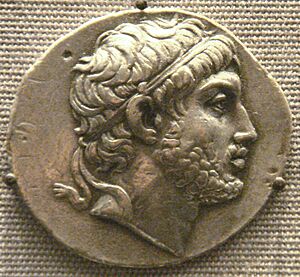
In 204 BC, the king of Egypt, Ptolemy IV Philopator, died. His son, Ptolemy V, was only six years old, making Egypt weak. King Philip V of Macedon and Antiochus the Great from the Seleucid Empire decided to take advantage of this. They secretly agreed to divide Egypt's lands between themselves. This started the Fifth Syrian War.
Philip V first attacked independent Greek city states in Thrace and near the Dardanelles. He successfully took cities like Kios. This made Rhodes and King Attalus I of Pergamon very worried, as they also had interests in that area.
In 201 BC, Philip launched another attack into Asia Minor. He surrounded the Egyptian city of Samos and captured Miletus. Rhodes and Attalus were even more concerned. Philip then attacked Attalus's lands, destroying temples outside Pergamon. Philip then invaded Caria, but the fleets from Rhodes and Pergamon trapped his ships in Bargylia. This forced his army to spend the winter there with very little food.
Even though Rhodes and Pergamon seemed to be winning, they were still very afraid of Philip. So, they asked Rome for help. Rome had just won a huge war against Carthage (the Second Punic War). Rome had also fought Philip V before in the First Macedonian War over Illyria, which ended in 205 BC. Philip's recent actions didn't directly threaten Rome, but the Roman Senate decided to help. They sent an ambassador, Marcus Valerius Laevinus, to investigate.
Around the same time, Athens had problems with Philip. Some people from Acarnania entered a sacred temple in Athens and were killed by the Athenians. In return, the Acarnanian League attacked Athens, helped by Macedonian soldiers Philip V sent. Soon after, King Attalus I arrived in Athens with ambassadors from Rhodes. He convinced the Athenians to declare war on Macedon. Attalus then sailed off, getting most of the Cycladic islands to join his side. He also tried to get the Aetolian League to join the war. Philip V responded by sending 2,000 foot soldiers and 200 horsemen to invade Athens and surround the city.
The War Begins: Rome Steps In (200 BC)
On March 15, 200 BC, new leaders took charge in Rome. Because of reports from Laevinus and requests from Pergamon, Rhodes, and Athens, the job of dealing with Macedonia went to Publius Sulpicius Galba. He called a meeting of the Roman assembly to vote on declaring war. At first, the assembly almost completely said no, which was unusual. People were tired of war. But Sulpicius convinced them to vote for war in a second meeting. He gathered soldiers, including veterans from the Second Punic War, and sailed across the Adriatic Sea to Greece.
The Siege of Abydos
While Rome was getting ready, Philip V was fighting another campaign near the Dardanelles. He quickly took several cities and then surrounded the important city of Abydos. Philip told the people of Abydos that if they wanted to surrender, they had three days. The citizens bravely threw their valuables into the sea and fought until the very last person died.
During this siege, in the autumn of 200 BC, Philip met a Roman ambassador, Marcus Aemilius Lepidus. The ambassador told Philip not to attack any Greek city or take land from Egypt. He also told Philip to settle his disagreements with Rhodes and Pergamon peacefully. Philip argued that he wasn't breaking any past peace agreements, but it didn't matter. As he returned to Macedonia after taking Abydos, he learned that Roman forces had landed in Greece.
Philip Attacks Athens and Chalcis
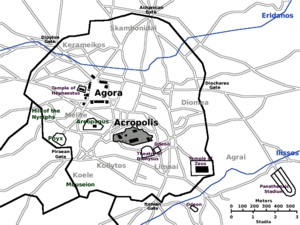
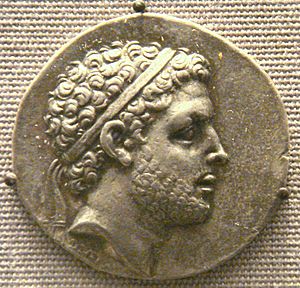
The Athenians, who were surrounded by Macedonian forces, asked the Romans for help. A Roman commander named Gaius Claudius Centho was sent with 20 ships and 1,000 men. The Macedonian troops around Athens then left. Claudius then led a surprise attack on Chalcis in Euboea, which was a key Macedonian stronghold. He caused a lot of damage.
Philip rushed to Chalcis with 5,000 foot soldiers and 300 horsemen. Finding that Claudius had already left, Philip quickly went to Athens. He defeated the Athenian and Attalid troops outside the city and set up camp. After burning sacred places and tombs outside the city walls, Philip left for Corinth. From there, Philip went to Argos to try and get the Achaian League to join his side. He offered to help them against Nabis of Sparta, but they refused. Philip then joined up with more troops and made three unsuccessful attacks on Eleusis, Piraeus, and Athens. He also destroyed the countryside around Athens before going to Boeotia. The damage to the rural areas of Athens was very severe.
Philip spent the rest of the winter getting ready for the Roman attack. He sent his young son Perseus with soldiers to stop the Romans from entering northern Macedonia. Philip also had settlements on the islands of Peparethos and Skiathos destroyed so enemies couldn't use them as naval bases.
Roman Campaigns (200-199 BC)
Sulpicius Invades Macedonia
During this time, the Roman commander Sulpicius set up a strong base in Illyria. A Roman force attacked the western border of Macedonia, capturing or destroying several cities. After this, Sulpicius gained the support of the Illyrians, Dardanians, and Athamanes. Philip, Sulpicius, and the Athenians all tried to get the Aetolian League to join their side, but the League stayed neutral for now.
In the spring of 199 BC, Sulpicius led his troops east into Illyrian territory that bordered western Macedonia. Philip gathered 20,000 foot soldiers and 4,000 horsemen and marched west. He set up camp on a hill overlooking Sulpicius's camp. After some small fights, Philip learned that the Dardanians had invaded northern Macedonia. The Macedonians secretly left their camp at night. When Sulpicius realized this, he chased Philip, forcing his way through a mountain pass. Sulpicius then destroyed lands in Eordaea and Elimeia before returning to his base. Philip split his army, sending some north to deal with the Dardanian invasion, while he went south.
At the same time, the Roman fleet, led by Lucius Apustius, sailed around Greece and met King Attalus near Hermione. Their combined fleet attacked the Macedonian military base on the island of Andros and captured it for Pergamon. More ships from Issa and Rhodes joined them. They then sailed north to the Chalkidike peninsula, but their attack on Cassandreia failed. They moved to northern Euboea, where they surrounded and captured Oreus, another important Macedonian naval base. Since it was autumn, the fleets went back to their home ports.
As these battles happened, Damocritus, a leader of the Aetolian League, decided it was time to join Rome. He and King Amynander invaded Magnesia and Perrhaebia, then continued to destroy Thessaly. Philip suddenly appeared and completely defeated their forces. He tried to capture the Aetolian city of Thaumaci, but gave up as winter approached. Philip spent the winter training his army and trying to get the Achaean League to join him.
Villius's Campaign
In Rome, new leaders took office on March 15, 199 BC. Publius Villius Tappulus was given command in Macedonia. He sailed to Greece and took over the army from Sulpicius. When he arrived, Villius faced a rebellion from 2,000 soldiers who wanted to go home after fighting in the Second Punic War. He solved this by sending their concerns to the Roman Senate. Philip marched west and set up camp on both sides of the Aoös river in a narrow valley. Villius marched to meet him but was still deciding what to do when he learned that his replacement, Titus Quinctius Flamininus, was on his way.
In Asia Minor, the Seleucid king Antiochus III invaded Pergamon. Because of this, Attalus couldn't help with the naval war in the Aegean Sea until a Roman message forced Antiochus to leave.
Flamininus Takes Command (198 BC)
Rome Invades Thessaly
When the new Roman leaders took office on March 15, 198 BC, the Senate ordered 8,000 new foot soldiers and 800 new horsemen for the war. Command in Macedonia was given to Flamininus. He was not yet thirty years old and loved Greek culture.
Flamininus was delayed for a while, but then he gathered the new forces, crossed the Adriatic Sea, and took over from Villius. The army camped in the Aous Valley, across the river from Philip's army, for forty days. At a peace meeting, Flamininus announced Rome's new demands. Before, Rome had only told Philip to stop attacking Greek cities. Now, Flamininus demanded that Philip pay for all the damage he had caused to Greek cities. He also demanded that Philip remove all his soldiers from cities outside Macedonia, including Thessaly, which had been part of Macedonia since 353 BC. Philip got very angry and left the meeting. Flamininus decided to attack.
In the battle that followed, the Battle of the Aous, Flamininus won. Even though the Macedonian army had a good position, Flamininus found a secret path through the mountains. This allowed him to send soldiers to attack the Macedonians from behind. Philip's army fell apart and fled, losing 2,000 soldiers. Philip managed to gather the survivors and retreat to Thessaly. There, he destroyed the city of Tricca to prevent it from falling into Roman hands and withdrew.
After the Roman victory, the Aetolians quickly attacked through Ainis and into Dolopia. King Amynander attacked and captured Gomphi in Thessaly. Meanwhile, Flamininus entered Epirus, which then joined Rome. Together with Amynander, he entered Thessaly. The army didn't face much resistance at first. But Flamininus got stuck in a long siege at Atrax. He eventually had to give up this siege and march south into Phocis to get supplies and winter lodging by capturing Anticyra. He then surrounded and captured Elateia.
While this was happening, Flamininus's brother, Lucius Quinctius Flamininus, took control of the Roman fleet and sailed to Athens. He met with the Attalid and Rhodian fleets near Euboea. Eretria was taken after tough fighting, and Carystus surrendered. This meant the entire island of Euboea was now under Roman control. The fleet sailed back around Attica and surrounded Corinth.
From there, Lucius, Attalus, the Rhodians, and the Athenians sent messages to the Achaian League to get them to join Rome. The League held a meeting at Sicyon to decide, and it was a very heated discussion. On one hand, the Achaeans were still fighting Sparta and were allied with Macedonia. On the other hand, their new chief leader was pro-Roman, and the Romans promised to give Corinth to the League. Representatives from Argos, Megalopolis, and Dyme, who were very close to Philip, left the meeting. The rest of the assembly voted to join the alliance against Macedonia.
The Achaean army joined the other forces surrounding Corinth. But after fierce fighting, the siege had to be stopped when 1,500 Macedonian soldiers arrived from Boiotia. From Corinth, a Macedonian general was invited to take control of Argos by pro-Macedonian people in the city, which he did without a fight.
Winter Talks
During the winter of 198/197 BC, Philip said he was willing to make peace. The groups met in November 198 BC. Philip refused to get off his ship to meet Flamininus and his allies. Flamininus insisted that all his allies be there. He then repeated his demands: Philip must remove all his soldiers from Greece, Illyria, and Asia Minor. Philip was not ready to agree to this. He was convinced to send a message to the Roman Senate. When this message reached Rome, the Senate demanded that Philip give up three key Macedonian strongholds in Greece: Demetrias, Chalcis, and Corinth. Philip's messengers said they didn't have permission to agree to this, so the war continued.
Philip then tried to free up his soldiers by giving the city of Argos to Nabis of Sparta. But Nabis then caused a change in the city and held a meeting with Flamininus, Attalus, and the Achaeans. At this meeting, Nabis agreed to stop attacking the Achaeans and to send soldiers to the Romans.
The Final Battle (197 BC)
Over the rest of the winter, Philip gathered all the men he could, including old soldiers and young boys. He had 18,000 men. He also added 4,000 light-armed soldiers from Thrace and Illyria, and 2,500 hired soldiers. All these forces gathered at Dion. Flamininus received more soldiers from Italy: 6,000 foot soldiers, 300 horsemen, and 3,000 marines.
At the start of spring, Flamininus and Attalus went to Thebes to get the Boeotian League to join their side. Because Flamininus had secretly brought 2,000 soldiers into the city, the League had no choice but to join Rome. At the meeting, King Attalus suddenly had a stroke while giving a speech and was partly paralyzed. He was taken back to Pergamon, where he died later that year.
In June 197 BC, Flamininus marched north from Elateia through Thermopylae. Along the way, he was joined by soldiers from Aetolia, Gortyn in Crete, Apollonia, and Athamania. Philip marched south into Thessaly. The two armies camped opposite each other near Pherae. Both armies then moved to the hills around Scotussa. Parts of the opposing armies met in the Cynoscephalae hills, leading to a full battle.
This battle was the most important one of the war. The Roman legions of Flamininus defeated Philip's Macedonian phalanx. Philip himself escaped on horseback, gathered the survivors, and retreated to Macedonia. Philip was forced to ask for peace on Rome's terms.
Other Battles
While the main battle was happening in Thessaly, three other fights took place in Achaea, Acarnania, and Caria. In all of them, the Macedonians were defeated.
In southern Greece, a Macedonian army attacked lands controlled by the Achaean League. The Achaean general, Nicostratus, with 5,000 men, blocked the path back to Corinth and defeated the Macedonian forces.
In Acarnania, there had been attempts to switch to the Roman side before the Battle of Cynoscephalae. But the League decided against it because they disliked the Aetolians. Lucius Flamininus therefore sailed to the Acarnanian capital of Leucas and launched a full attack. It was very difficult, but thanks to people inside the city who helped, it was eventually captured. Soon after, news of the Battle of Cynoscephalae arrived, and the rest of the Acarnanians surrendered.
In Asia Minor, the Rhodians led 4,500 hired soldiers into Caria to take back their territory. A battle took place with the Macedonian forces at Alabanda, where the Rhodians won. The Rhodians then took back their lands but failed to capture Stratonicea.
What Happened Next: The Peace and Freedom
The Peace Treaty
An agreement to stop fighting was made, and peace talks were held. Philip agreed to leave all of Greece and give up his lands in Thrace and Asia Minor. Philip had to rush off almost immediately after the agreement to deal with an invasion of northern Macedonia by the Dardanians.
The treaty was sent to Rome for approval. Even though one of the new Roman leaders tried to make the war last longer, the Roman assembly voted to make peace. The Senate sent ten officials to help decide the final peace terms.
The final peace was made with Philip in spring 196 BC. Philip had to remove all his soldiers from Greek cities in Europe and Asia. These cities were to be free and govern themselves. Philip also had to pay a large amount of money, 1,000 talents, as a war payment. Half was paid right away, and the rest in ten yearly payments. He had to give up almost his entire navy, keeping only his main ship. His army was limited to 5,000 men, could not have elephants, and could not go outside his borders without Rome's permission.
The Freedom of the Greeks
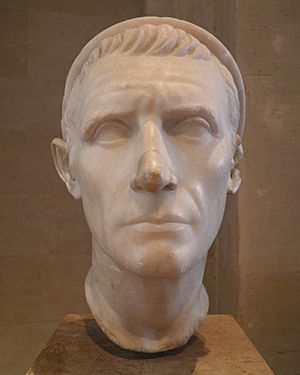
At the Isthmian Games in May 196 BC, Flamininus announced the "Freedom of the Greeks." Everyone at the Games cheered loudly. This announcement listed the communities that were now free. However, the Romans kept soldiers in important cities that had belonged to Macedon – Corinth, Chalcis, and Demetrias. The Roman armies didn't fully leave Greece until 194 BC.
The idea of "Greek freedom" was not entirely clear. Even though Flamininus's announcement listed the communities that were now free, the Romans quickly took on the role of protecting Greek freedom more generally. The idea of Greek freedom was immediately used by Rome and its allies to justify their actions elsewhere. For example, the War against Nabis of Sparta in 195 BC was supposedly fought for the freedom of Argos.
Seleucid Conquest in Asia Minor
The whole war had started because Philip V and Antiochus III had agreed to attack Egypt. While the war was happening in Greece, Antiochus III completely defeated the Egyptian forces in Syria. Since Philip had given up his claim to the cities in Asia Minor that used to be under Egyptian control, Antiochus III now moved into Asia Minor to take them for himself. The problems caused by this would lead to another big conflict, the Roman–Seleucid War, which began in 192 BC.
See also
- Military history of ancient Greece


